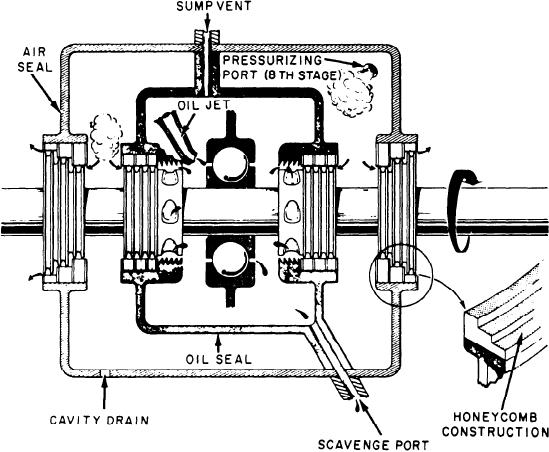
Figure 2-50.--Bearing sump.
outlet fitting on the enclosure base, and is returned
Lube Oil Flow
to the LOSCA.
At the LOSCA the oil passes through the
Lube oil is gravity fed from the oil tank in the
scavenge filters to the scavenge check valve.
LOSCA through the ship's piping to an inlet
The oil then goes through the oil cooler where it
fitting in the enclosure base. It is then fed to the
is cooled by the MRG (2190 TEP) lube oil. The
inlet of the supply element of the lube and
cooled oil is then routed to the oil tank for storage
scavenge pump. From the supply element of the
and deaerating.
pump, the oil passes through the supply duplex
filter. It then goes through a check valve and
IGNITION SYSTEM
into a supply manifold. From the supply
manifold, the oil is distributed to the four
The ignition system provides ignition to start
sumps and the TGB. Each end of the sump has
combustion in the engine. It has ignition exciters
a labyrinth/windback oil seal and a labyrinth air
and two spark igniters located in the combustor.
seal (fig. 2-50). This is to prevent oil leakage from
The system is actuated by an electronic signal
the sumps. The cavity between the two seals is
during the engine start sequence. It is generated
pressurized by eighth-stage air ejectors. The
either manually by the operator or by the
pressure in the cavity is always greater than the
electronic timing controls. The engine must reach
pressure inside the sump. Air flowing from the
a speed of 1,200 rpm prior to ignition; then, if
cavity, across the oil seal, prevents oil from
performing a manual start, you must energize the
leaking across the seal.
igniters before opening the fuel valves. When
you start the engine in the automatic mode, the
The scavenge oil is drawn in from the sumps
fuel valves will not open unless the igniters are
and TGB by the five scavenge elements of the
already functioning. This prevents excess fuel
pump. It passes through the pump, through an
2-44

